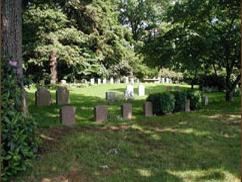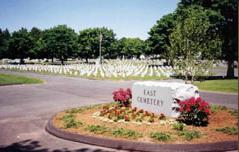Manchester's Burying Grounds
Go to Slideshow
 When Manchester was first settled near the end of the seventeenth century the only cemetery for Orford Parish was what is
known as the Ancient Burying Ground in downtown Hartford. By 1711, the settlers east of the Connecticut River were buried
in Center Cemetery on Main Street in East Hartford.
When Manchester was first settled near the end of the seventeenth century the only cemetery for Orford Parish was what is
known as the Ancient Burying Ground in downtown Hartford. By 1711, the settlers east of the Connecticut River were buried
in Center Cemetery on Main Street in East Hartford.
Manchester's first cemetery, laid out in 1740, is the West Cemetery on Spencer Street near the entrance ramp to I-384. (Note that the cemetery entrance was moved in 1999 from Spencer Street to the northwest corner just beyond the I-384 on-ramp.)
The first acre of East Cemetery on East Center Street was deeded to the town of Hartford by Thomas Pitkin in 1751.
Buckland Cemetery in Northwest Manchester became public in 1811. These three cemeteries plus the new Hillstown Road Cemetery are maintained by the town of Manchester.
Cheney Cemetery, a two acre plot near the northeast corner of East Cemetery, is owned by the Cheney Cemetery Association.
Beth Shalom Memorial Park in the southeast corner of East Cemetery is leased from the town.
The other religious cemeteries, St. Bridget on Oakland Street (1870), St. James on Broad Street (1902) and St. John on Jefferson Street (1930) were maintained by the parishes until the Archdiocese of Hartford took over St. James and St. Bridget in 1969. The office for these and other nearby Catholic cemeteries is at St. James Cemetery.
 East Cemetery is by far the largest cemetery in Manchester, beginning with its first acre, deeded by Thomas Pitkin to the Town of Hartford in 1751; the area was incorporated into East Hartford in 1783 and then as Manchester in 1823. Additional purchases of land in 1843, 1856, 1867, 1896, 1925, and 1955 expanded the cemetery to its present 51 acres. It is the second oldest cemetery in Manchester. The late John Spaulding, author with his wife Betty of a tour-booklet of East Cemetery suggested, "Drive through the cemetery and observe the different types of cemetery development that occurred over the last 250 years. The first acre was next to East Center Street and has about five hundred
individual graves. The next area to the south is laid out in rectangular plots. The area south of the cemetery office is
laid out as a 'rural cemetery' following the precedent set by Mount Auburn Cemetery in Cambridge, Massachusetts. At one
time there was a pond near the office spanned by a bridge. As the newer sections near Westminster Street were developed,
the design reverted to a rectangular layout, presumably for ease of maintenance." The twenty page "Self-Guided Historical Walking Tour" booklet for East Cemetery is available at our museum store and online walking tour booklet. It includes the story of the Cheney Cemetery, a 2.03-acre parcel which abuts the East Cemetery, and was deeded to the Cheney Cemetery Association by Cheney Brothers, Inc., in 1916. See Cheney Cemetery pamphlet, with information from "If All the Great Men," about some of the family members whose gravestones are located at the cemetery.
East Cemetery is by far the largest cemetery in Manchester, beginning with its first acre, deeded by Thomas Pitkin to the Town of Hartford in 1751; the area was incorporated into East Hartford in 1783 and then as Manchester in 1823. Additional purchases of land in 1843, 1856, 1867, 1896, 1925, and 1955 expanded the cemetery to its present 51 acres. It is the second oldest cemetery in Manchester. The late John Spaulding, author with his wife Betty of a tour-booklet of East Cemetery suggested, "Drive through the cemetery and observe the different types of cemetery development that occurred over the last 250 years. The first acre was next to East Center Street and has about five hundred
individual graves. The next area to the south is laid out in rectangular plots. The area south of the cemetery office is
laid out as a 'rural cemetery' following the precedent set by Mount Auburn Cemetery in Cambridge, Massachusetts. At one
time there was a pond near the office spanned by a bridge. As the newer sections near Westminster Street were developed,
the design reverted to a rectangular layout, presumably for ease of maintenance." The twenty page "Self-Guided Historical Walking Tour" booklet for East Cemetery is available at our museum store and online walking tour booklet. It includes the story of the Cheney Cemetery, a 2.03-acre parcel which abuts the East Cemetery, and was deeded to the Cheney Cemetery Association by Cheney Brothers, Inc., in 1916. See Cheney Cemetery pamphlet, with information from "If All the Great Men," about some of the family members whose gravestones are located at the cemetery.
Inscriptions on the gravestones in Manchester's public cemeteries were recorded by the Orford Parish Chapter of the
Daughters of the American Revolution (DAR) about 1927. Copies are not available locally but may be found at the Rhode
Island Historical Society in Providence and at the DAR headquarters in Washington, D.C. In November 1934, all of the
cemeteries in Manchester were recorded by a Works Progress Administration (WPA) project under the direction of Charles R.
Hale and are available at the Cemetery research at CT State Library.
 Ruth Shapleigh Brown of the Connecticut Gravestone Network
has provided us with some general information about CT cemeteries in the Hartford area, and about the symbolism
which we find on many of the older headstones in our cemeteries.
Ruth Shapleigh Brown of the Connecticut Gravestone Network
has provided us with some general information about CT cemeteries in the Hartford area, and about the symbolism
which we find on many of the older headstones in our cemeteries.
| For information on the Hartford area cemeteries, please click
|
For information on the symbolism associated with headstones and family plots, please click
|
